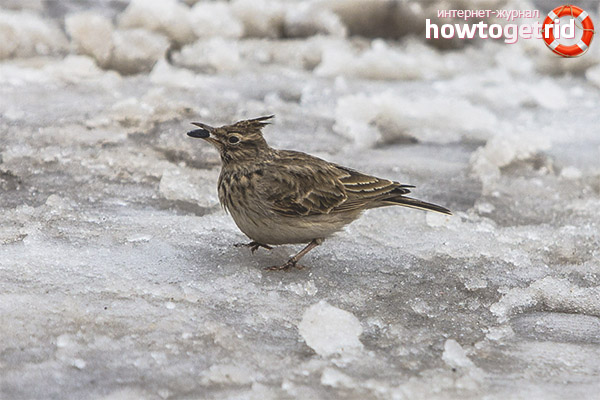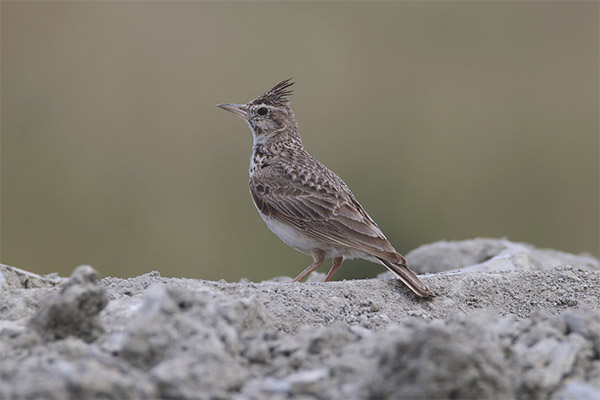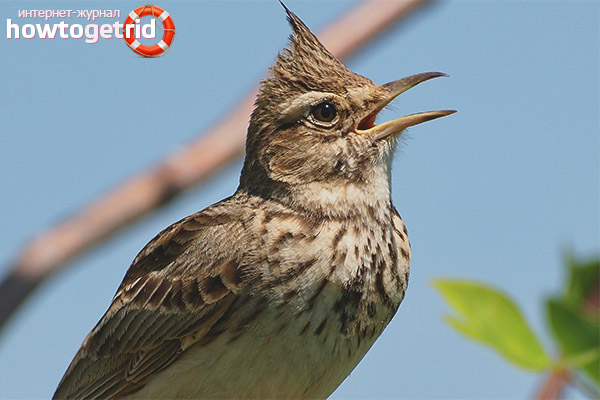The content of the article
The Crested Lark is a bird with a piercing voice that masterfully copies the voices of other birds. It resembles the common field lark, only more stocky and wider at the shoulders. He likes to build nests in the places where people live, so the people called him “neighbor”. What do people know about this bird?
general information
Skylark crested from the group of passerine, family of larks. There are five subspecies, dividing by habitat. Suppose there is a Central Asian, Belarusian, Northern Iranian lark and the like. But their appearance is the same regardless of their habitat.
Appearance
The size of the bird is average. Height of birds, as a rule, 17-18 cm, weight from 40 to 55 grams. Head decoration is a small crest, which gave the name of the bird.When walking, the tuft, decorated on the end with long feathers, constantly rises and falls.
Long beak slightly bent down. The wings, about 10 cm long, look quite large compared to the body. This creates the appearance that a bird flying high in the sky is quite large. The paws are strong and very strong, twined with muscles - the lark has to walk a lot and often, looking for food.
The visible plumage is dark brown, but on the chest and around the neck is somewhat lighter. Such a color is a necessity and helps to mask, hiding in the thickets of grass from all sorts of predators. Moreover, he hides so well that he becomes almost imperceptible.
Behavior
The crested lark, like other members of the family, is not picky. He is equally well and, where people, and in a desert area.However, most of them nest in either the steppe zone or where there are meadows, as this is the most optimal habitat zone.
This bird, which lives in the southern regions, is settled, as the warm dry climate suits it at any time of the year, and the inhabitants of the northern regions with the onset of cold weather set off to spend the winter in the warm southern edges. They always come back to the same places where they flew from - the larks are tied to the territory in which they live. Leave and change it can unless perhaps because of proliferated predators or because of a lack of food.
Habitats
Prefers open spaces without trees, but with thickets of low-growing grass, half-empty and steppe zones. Inhabits the southern and central European regions, in the north of Africa, in many parts of Asia, in the north of India, in the western Chinese provinces and in Korea. On the territory of the former USSR, it is common in the southern regions of the European part, the Crimea and the Caucasus.
Nutrition

The diet of the crested lark is quite diverse. It feeds on everything that manages to find - both food of plant origin and all kinds of insects.Food is not looking like most birds - in flight, and wanders the earth. Moving from one place to another, explores the crust in an attempt to find something edible.
For example, on a fine sunny day, he is looking for ants and beetles. With the help of a long beak, it is easy to pull prey out of inaccessible shelters, splitting easily any durable shell. She likes to feast on earthworms, which she searches for in wet rainy weather. It catches grasshoppers, ants, dragonflies, flies. But before you eat this flying prey, it tears off its wings to make the digestion process easier.
From plant food consumes all the seeds of plants and cereals. When winter comes, the lark becomes a vegetarian - because all insects are asleep. The bird finds areas with a small amount of snow and starts digging up frozen berries, picks out roots.
Singing and voice
As a rule, the presence of a crested lark gives it a melodic, second only to the nightingale’s trills, the voice is a kind of business card by which it will be recognized even without seeing.In addition, the bird performs not only the motives invented by it, but is able to imitate the voices of other birds.
The fact that the lark's voice serves as his main weapon is also important. At the onset of danger, he makes a piercing loud cry, disorienting the attacker. While he wakes up, the lark has time to escape or attack. It only works like this only once, and an experienced predator is no longer buying it.
Mating games
Also, the voice has another important purpose - with its help, the males call females for mating. As soon as spring comes and it becomes warm, the search for the second half begins in the birds. Most often, old couples reunite, finding each other. Crested larks remain loyal to their partner, the union can last more than one year. And young males begin to prove to females that they are better than competitors.
The meaning of ongoing battles - who will sing someone. Males surround the lady and dance around, spreading their wings, shaking their tails and stretching their necks. At the same time constantly singing, without stopping for a second. The winner is the longest held out, or the one to whom the female preferred.
Nesting and breeding
The nest is built by females, and on the ground, and not in the crowns of trees. For the construction of any material is used: grass, pieces of branches, cobwebs, moss, and the like, which brings the male.
As a rule, the female makes two laying during the year - the first one is up to 6 yellowish eggs, the second one is 3-4 eggs. Hatching lasts from 10 days to two weeks. The hatched chicks are fed by both parents, fed three to five times a day, bringing in animal food - beetles, insects, worms. Birds put food into the gaping beak of babies, and the one who opens the beak most often receives more than the nest. After 9-10 days, the chicks leave the nest on the ground and begin to independently search for food. Those who do it poorly, the parents are still fed. Three weeks later, the young chicks that have grown up stand on the wing and fly away from their parents, starting an independent life.
The enemies
Interesting Facts
- The lark usually sings, being on the ground or some kind of elevation. But often sings and during the flight.
- It seems that the lark sings endlessly, without getting tired. But this is not so - the song lasts about 12-14 minutes, after which the feathery needs rest.
- Larks love to swim in the sand, so the plumage often seems dirty and neglected.
- The lark's dislike for trees is simply explained: the structure of the bird's fingers is such that it sits on a branch difficult - a long claw grows on the back side of the paw, making it difficult to sit on a tree.
Video: Crested Lark (Galerida cristata)












To send